
What is the difference between Independent Living and Assisted Living?
Independent living communities primarily cater to the social needs of residents, as many can live independently with minimal support.
Assisted living facilities, on the other hand, provide assistance with daily activities while allowing residents to maintain their independence.
Here are some other ways in which independent and assisted living differ:
1. Cost of Independent Living vs. Assisted Living
Assisted living typically follows a rental model, with monthly fees covering maintenance, housekeeping, security, nursing observation, three daily meals, programming, and round-the-clock staffing for reassurance or personal care.
Personal care assistance can encompass bathing, dressing, grooming, toileting, and assistance with walking or mobility. Supervision with medications is also offered through professional services. While assisted living is an out-of-pocket expense, many individuals have Long Term Care Insurance policies that cover a portion of the monthly fee.
The cost breakdown for independent living is slightly different. In most continuing care retirement communities, residents pay an entrance fee upon moving in (typically refundable up to 75-90% upon leaving) and an additional monthly fee to cover maintenance, housekeeping, security, meals, and programming.
2. Medical and Supportive Care
Generally, independent living facilities cater to older adults who require minimal assistance or medical care, so these services are often not provided as you need a license to do so. In an assisted living facility, staff members assist residents with their daily activities through a coordinated service plan. Assisted living communities are required to have staff members at all times to meet the needs of the residents that reside there for convenience and safety. Most assisted living communities have licensed nurses or registered nurses available to assist with medication management and evaluations should a medical need arise.
3. Community Design
Independent living communities are often comprised of multiple buildings spread across large campuses, with a central gathering area for programming and meals. The spaces, including apartments or cottages, maybe more spacious, and there is typically more distance to travel between buildings, either on foot or by car.
Assisted living facilities, on the other hand, tend to have a smaller footprint and are more self-contained. Well-designed communities have nooks to rest while encouraging older adults to keep moving without requiring a need for a wheelchair to manage long distances way before it is necessary. Many of the resident's needs are met within the assisted living building itself such as dining, social programs, flexibility to add spaces to match interests, and transportation to/from medical or social appointments. Memory programs within assisted living facilities are even more intentionally designed, with features like enhanced lighting, color coding, visual cues, memory boxes, easily navigable walking paths, and secure outdoor and indoor spaces.
4. Family Involvement
Families are encouraged to immerse themselves in the community in independent living, but the primary decision-making generally lies with the residents. Family members are welcome to visit their loved ones and take advantage of the various amenities offered throughout the community.
In assisted living, residents continue to play an active role in their choice and day. Assisted living communities navigate who is the primary decision maker, and almost always, they navigate communication between both residents and their families. Family members often play a more active role in caring for their loved ones in assisted living, especially for residents living with dementia. Designated family members are informed about their loved one's progress and are involved in care planning.
Family support and interaction are crucial for a person's physical, mental, and emotional well-being. It's essential for families and friends to feel welcome in independent or assisted living communities and continue to make the community feel like home to the residents that live there.
5. Independent Living and Assisted Living Amenities and Programming
Both independent and assisted living communities offer a range of programming and amenities, regardless of the level of care needed. Typical amenities and services in assisted living include private apartments, housekeeping, 24-hour staff, transportation services, events and social opportunities, and various dining options. Most facilities have common living areas such as small libraries, café areas, and gaming rooms for casual social activities.
In independent living, one meal at dinner is often included as part of the monthly fee, and many communities offer different dining options, from fine dining to casual take-out, or residents can cook their meals at home. In assisted living, all three meals are usually included, and residents are encouraged to dine in the communal dining room with neighbors. Mealtimes are important for fostering social connections.
Both types of communities typically offer a diverse calendar of learning and entertainment opportunities. Assisted living communities may provide more programming hours per day, particularly in memory programs, and activities may be tailored to the physical and cognitive abilities of the residents.
If you have any further questions or need additional information, we are here to help. With over two decades of experience in the assisted living industry, The Birches Assisted Living and Memory Care community is dedicated to providing the best care, support, and choice for your loved one.
Our team is ready to assist you in finding the perfect home that meets their unique preferences and needs. Please feel free to reach out to us at (630) 789-1135 or through our contact form for more details on senior living options.

